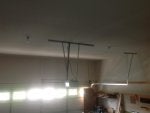I want to add lighting in the garage shop. As you can see in the pic, I have two light sockets for incandescent lights.
Can I just remove the light socket, put duplex sockets in the boxes and then plug in two 2-lamp fixtures in each one? Any concerns or better suggestions? Permitting needed?
T5 or T8 or T12? I am thinking T8.
Main need/want is BRIGHT, realistic lighting.
Can I just remove the light socket, put duplex sockets in the boxes and then plug in two 2-lamp fixtures in each one? Any concerns or better suggestions? Permitting needed?
T5 or T8 or T12? I am thinking T8.
Main need/want is BRIGHT, realistic lighting.





